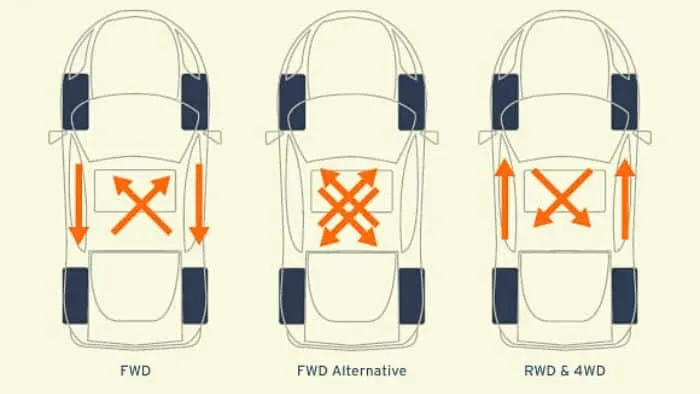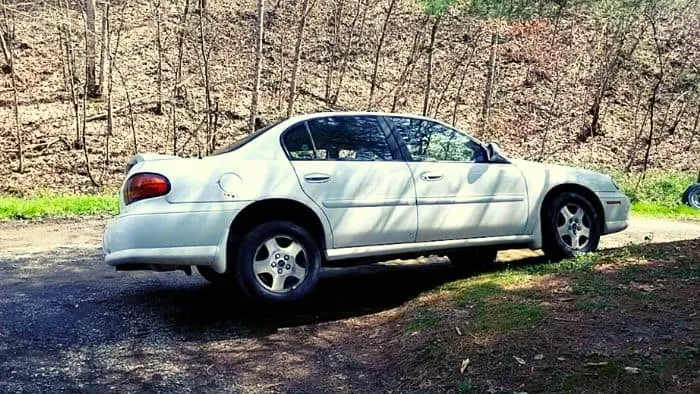Teenagers need to master many life skills in order to navigate the world of adult responsibilities.
As you embark on your journey of automotive independence, one essential task to master is changing a flat tire.
But have you ever wondered how long this pesky chore takes?
This article breaks down the time-consuming task of changing a car tire and offers some helpful tips for teenage motorists.
So grab your lug wrench, and let’s get rolling!
How Long Does It Take To Change A Tire?
A car tire change can take anywhere between 5 to 45 minutes.
The time it takes to change a car tire will depend on if a professional is changing the tire for you or if you’re doing it yourself.
It is generally advised that you take your car to a professional to perform a tire change because they have all the tools to ensure the job is done correctly.
If you plan on changing a car tire yourself, then you’ll need to learn the skills and do everything in the correct order to avoid failure or injury.
You’ll need several tools and equipment, such as a jack, lug wrench, and spare tire.
You’ll also need to find a safe and level place to change the tire, such as the shoulder of the road or a parking lot.
It might take longer to change the tire if you are on the roadside and not at home.

The following tasks might be involved:
- roll the car off the roadway and into a safe place to avoid a rear-end or side collision with other vehicles
- put on your emergency flashers (or hazard lights) to warn other motorists
- place your emergency triangle on the road so that it is visible to other motorists
- put tools and equipment back into the car after you are done
You also have to factor in your safety, meaning that you must be aware of passing vehicles.
If you’re looking for an opportunity to practice changing a flat tire, it’s probably best to do it at home in your driveway with someone experienced watching.
You might be interested to know that F1 tire changes for all 4 tires take only about 2 seconds in total!
A standard F1 pit crew has around 20 highly trained people on hand to assist.

👉 Find out what each F1 pit crew member does during a pit stop.
Other pro race car series tire changers take between 5 and 15 seconds.
How Long Does It Take To Change A Tire Yourself?
It can take anywhere between 10 to 15 minutes to change a tire yourself. The time it’ll take you to change a car tire will depend on how skilled you are, the tools and equipment you have available, the location (whether it’s by the roadside or in your driveway), as well as the weather conditions.
Changing a tire yourself can be a satisfying and empowering experience. With practice, you can learn to change a tire quickly and efficiently, giving you peace of mind and the ability to handle unexpected situations.
How Long Does It Take To Change 1 Tire?
Changing a single car tire can take only 10 to 15 minutes, depending on the situation. Some factors that affect the time it takes can include the location of the tire change, if you have all the tools you need to get the job done and if you have any experience changing a car tire.
How Long Does It Take To Change 2 Tires?
It can take minutes 20 to 30 minutes to change two tires. However, the time it takes to change a tire may vary depending on the situation, vehicle model, and the person doing the job.
How Long Does It Take To Change All 4 Tires?
Changing four tires can take approximately 30 to 60 minutes. Typically you’ll get all four tires changed at a service center, so the time will depend on the equipment the mechanic uses. A professional mechanic (or experienced vehicle owner) will need about 10 minutes to replace a car tire.
This process might also involve checking the brakes, balancing the tires, and aligning the wheels. You usually don’t have to replace all the tires at once, and you can repair them in pairs choosing to tackle the front tires or the rear tires.
How Long Does It Take Professionals to Change a Tire?
It takes professionals 5 to 10 minutes to change a single tire. The actual service time might be anywhere between 30 minutes to 4 hours, depending on the number of people getting their tires serviced at the same time and the number of staff members available. The time will increase if there is a need for extra services, like tire wheel rotation and balancing.
By hiring a professional to change your car tire, you can save time and ensure the job is done correctly.
Watch to see how professionals mount and balance a car tire:
How Long Does It Take To Change Tires At Costco?
It takes 30 minutes to 1 hour to change tires at Costco. If they are busy, it might take longer. To avoid waiting too long, you can book an appointment beforehand. Optional services include new valve stems, lifetime rotation and balancing, flat repairs, inflation checks, and a 3-year road hazard warranty.
How Long Does It Take To Change Tires At Walmart?
Walmart is typically cheaper than other fitment centers, however, changing tires at Walmart can take anywhere between 1 to 4 hours due to long queues. Tires sold by Walmart are cheaper than those sold by competitors. However, they are as durable as the other premium-quality tires and come with a good warranty.
How Long Does It Take To Change A Tire AAA?
A tire change by AAA can take 10 minutes or more, depending on where you request their services and how long it will take them to deploy a staff member to your location. Depending on your location, the type of assistance you need, and the road conditions, AAA roadside assistance can take up to 21 minutes to arrive.
How Long Does A Tire Change Take At Firestone?
It takes 1 to 1.5 hours to change a tire at Firestone, including removing it, replacing it with a spare, and checking the wheel balance. Firestone offers a guarantee that your car will be ready in the quoted time. Otherwise, they’ll take 10 percent off your next visit.
How Long Does It Take To Change A Tire At Discount Tire?
A tire change at Discount Tire is normally completed within 45 minutes. The whole process involves unmounting and mounting the tire and torquing it properly. Discount Tire offers are free tire pressure checks and, in the process, will also check your tires for problems.
Do You Need Wheel Alignment After Changing Tires?
It is recommended to get wheel alignment after changing tires to ensure the tires wear out evenly and make it possible to get maximum longevity from them. Properly aligned wheels mean that you’ll be less likely to have a tire malfunction, and your car’s suspension will perform optimally.
There are several signs that your car may need a wheel alignment, such as uneven tire wear, pulling to one side while driving or vibrations in the steering wheel. If you notice any of these symptoms, it is a good idea to have your wheels aligned by a professional.
If you have just installed new tires, it is a good idea to have your wheels aligned to ensure that the tires wear evenly and perform optimally. Similarly, if you have recently hit a pothole or curb, your wheels may be out of alignment and require adjustment.
How Long Does It Take To Change 4 Tires And Alignment?
Changing four tires and alignment can take 1 to 4 hours, depending on how busy the fitment center is. In addition to alignment, you should also have the wheels rotated and balanced. Factors that affect the time taken to change and align 4 tires include the number of cars in the service queue and the number of mechanics available.
Do You Need Tire Rotation After Changing Tires?
You don’t need tire rotation if you are replacing all four tires. The purpose of tire rotation is to even out wear so that all tires reach the end of their service life at the same time. Tires that are brand new don’t have any wear to even out.
Front tires of a front-wheel drive vehicle tend to wear out faster than rear tires.
When you rotate your tires regularly, then wear is spread evenly across all four tires, and their tread life is maximized.
It is recommended that you rotate your tires every 5,000 miles (8,000 kilometers) or every 6 months.
You can tell that you need tire rotation if there is uneven wear between tires, vehicle vibration, or if one tire loses pressure faster than the others.
You can rotate your own tires; however, there are specific tire rotation patterns depending on if your car is a front-wheel drive, rear-wheel drive, or a 4-wheel drive vehicle.

Source: https://www.tirebuyer.com/
How Long Does An Oil Change And Tire Rotation Take?
An oil change takes about 20-45 minutes, while a tire rotation can take around 40-60 minutes. Depending on how backed up the shop is at the time of your visit, your total wait time may vary.
If you perform the oil change yourself, then it can take significantly longer, plus you’ll need to dispose of the oil safely and legally.
You should ideally change your car’s oil every 3,000 miles (4,800 kilometers) or every 6 to 8 months.
How To Change A Tire
Changing a tire is a relatively simple process that can be done by most people.
To change a tire, you’ll need a few tools and supplies, including a spare tire, a jack, a lug wrench, and a wheel wedge or block of wood.
Here are the steps to change a tire:
- Find a safe and level location to change your tire.
- Make sure the car is in park (if automatic) or in 1st gear (if manual), and the parking brake is engaged.
- Use your hazard lights to increase your visibility.
- Place the wheel chock or block of wood behind the tire that is opposite the one you will be changing to prevent the car from rolling.
- Use the lug wrench to loosen the lug bolts on the tire you are changing. Turn them counterclockwise to loosen them, but do not remove them yet.
- Position the jack under the car and raise the car until the tire is off the ground. Make sure the jack is securely positioned before raising the car.
- Remove the lug nuts and the tire. Place the spare tire on the wheel and hand-tighten the lug nuts.
- Lower the car back down and use the lug wrench to fully tighten the lug nuts.
- Check the tightness of the lug nuts and make sure they are evenly tightened.
- Store the flat tire and the tools in the trunk, and you’re ready to go!
It is important to note that changing a tire is not a difficult process, but it is important to take your time and follow the steps carefully to ensure your safety and the safety of others.
Always ensure your car is secure and on level ground before changing a tire, and preferably never attempt to change a tire on a busy road or highway.
Watch below to see the steps to change a tire:
Can You Change A Tire By Yourself?
You can change the tire yourself if you have the skills and the right tools usually provided with the car by manufacturers. If you don’t have experience and tools, it would be best to take the vehicle to a tire shop to get the job done correctly by a professional mechanic.
Is Changing A Tire Easy?
Changing a tire is not particularly difficult, but it can be physically demanding. You’ll need adequate physical strength to get the lug nuts off and crank the jack. If you have changed a car tire before then, it’ll be easy as long as you have the correct tools for the job, which are mainly a jack and lug wrench.
If you’re unsure about changing your own car tire, then rather take your car to a tire shop that has hydraulic and pneumatic tools to make it a speedy and safe operation.
What Tools Do You Need To Change A Tire?
To change a tire, you’ll need the following:
- A spare tire – a smaller-diameter replacement tire or “donut tire” is usually available with most vehicles.
- A manual car jack – a mechanical device to lift the car and raise the flat tire off the ground.
- A lug wrench – to loosen and tighten the lug nuts that hold the tire onto the wheel.
- A wheel chock, wheel wedge, or block of wood – to prevent accidental vehicle movement while changing the tire.
These tools are typically found in the trunk of your car, but it is a good idea to check before you find yourself stranded with a flat tire.
In addition to these tools, it is also a good idea to have a flashlight, gloves, and a reflective vest in case you need to change a tire at night or in poor visibility. These items can help to improve your visibility and safety while changing the tire.
Always make sure you have these tools on hand before you need to change a tire, and be familiar with how to use them before you find yourself stranded on the side of the road.
What Is The Fastest Way To Change A Car Tire?
The fastest way to change a car tire is if you have all the proper tools in your car and they are easily accessible.
You’ll also need a spare tire that is inflated and in good condition.
The location also contributes to how fast a tire change can take.
Changing a car tire at home or a dealership will be much quicker than if you must change a tire at the roadside.
You should refer to your car manufacturer’s manual to perform the tire change correctly. The instructions will indicate the correct points to place the jack on the car.
You should be cautious when jacking up your car. Newer cars have variable frame thicknesses to reduce overall weight. So always be careful where you place the jack.
How To Change A Car Tire In 5 Minutes Or Less
Watch Juliana show how to change a tire in 5 minutes or less:
Juliana recommends using the following tools:
How To Change A Tire Without A Jack
Changing a tire without a jack will require you to figure out how to lift the car off the ground so that you’re able to remove the wheel.
OPTION 1: The first option is to roll the car onto a mound of dirt (or a small hill).

Source: https://youtube.com/
You can also use the pavement to raise the car, as demonstrated below:

Source: https://youtube.com/
OPTION 2: The second option is to place your car over the edge of a small ledge or pavement.

Source: https://youtube.com/
OPTION 3: The third option is to use a wooden block, large log, or tree stump to support the car under the side of the axle closest to the flat tire. Make sure the object will support axle. Then assuming you’re on soft ground, use a shovel or your hands to dig a hole underneath the flat tire. Keep digging until you have enough space to remove and replace the tire.

Source: https://youtube.com/
⚠️ CAUTION About Changing A Tire Without A Jack
Note that these methods are not recommended and should only be used in emergency situations when you do not have a jack or other tools to change a tire. It is also important to be cautious and use proper safety techniques when changing a tire without a jack.
Changing Tires – Related Questions
How much should I pay to change a tire?
You can pay anywhere between $15 to $150 to change a standard car tire (12″ – 15″ wheels) which includes the service fee that covers mounting, balancing, and rotation. The price will vary depending on the type of car, vehicle model, year of manufacture, and the dealership you go to. For crossovers, SUVs, and other larger vehicles (16″ – 20″ wheels), you can pay anywhere between $100-350 per tire.
How many years do tires last?
Tires can last anywhere between 4 to 10 years depending on how many miles you drive per year, the type of tire and manufacturer, maintenance routine, your vehicle, driving style, and road conditions. On average, people drive between 12,000 to 15,000 miles a year, which means a normal set of tires should last for 60,000 to 75,000 miles, or about 4 to 5 years.
How often should you replace tires?
The majority of tire manufacturers recommend inspecting or replacing your tires after 6 years, and definitely replacing them after 10 years, regardless of how much tread is left on them.
Tires should be replaced when you notice the thread is worn out and exposed and weathering cracks on them. The rubber material on tires will start wearing off soon as they are fitted on the wheel, inflated, and loaded by the car’s weight. Tires will have natural wear with usage and therefore need to be replaced for optimum tire performance.
Can you drive on a flat?
No, you should ideally not drive on a flat tire. If you do drive on a flat, then you risk damaging your tire beyond repair. At most, you can drive a few hundred yards before you irreparably destroy the tire. You also risk damaging your vehicle further, notably the wheels, brakes, as well as suspension, and steering system.


